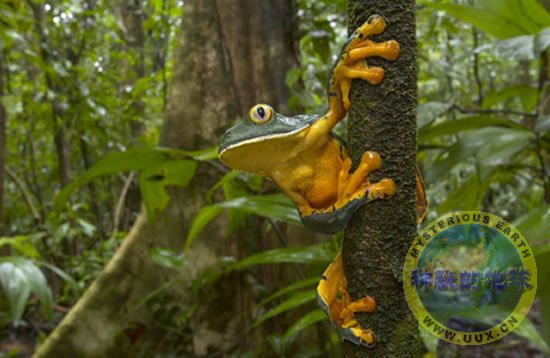Sun-Loving Frogs Get Skin Check With Eye Doctor's Tool
A sun-loving splendid leaf frog pauses on a tree trunk in Costa Rica.
Conservationists in Manchester, England, are using a tool borrowed from eye doctors to study how frogs from the Central American country are being affected by global warming.
The work may help researchers better understand why some unusual frogs bask for long durations in the hot sun despite the risk of damaging their thin, permeable skin.
Photograph by Piotr Naskrecki/Minden Pictures/Getty Images
Anne Minard
for National Geographic News
November 30, 2007
Sun-loving tree frogs from Costa Rica could get a reprieve from dissection—thanks to a tool borrowed from eye doctors.
The technique, called optical coherence tomography (OCT), can produce images to a depth of a few millimeters and is normally used to examine the human retina, a thin layer of cells that lines the back of the eyeball.
But animal conservationists in Manchester, England, are using OCT to study skin characteristics in frog species that bask in the sun—an unusual trait among thin-skinned amphibians.
The team hopes that the noninvasive method will yield clues about the frogs' susceptibility to a deadly chytrid fungal infection, a disease found worldwide that has been linked to global warming.
Andrew Gray is curator of herpetology at the Manchester Museum and a co-author of the new work, which also involves researchers at the Photon Science Institute at the University of Manchester.
So far Gray and his colleagues have been testing the OCT technique on the museum's extensive collection of rare Phyllomedusine and Litoria tree frogs.
The new method isn't ready for publication, the researchers say, but it has been unveiled at two in-house poster sessions.
"We currently know that a few specimens of frogs suffering from skin infections appear to become immune to chytrid after suffering [the disease] and then being cleared through treatment," Gray said.
"If this is due to skin structure change or difference, we hope the OCT equipment being developed will be able to let us see how—without dissecting the frogs."
Basking Frogs
The frogs at the heart of the Manchester study lead unusual lives in their wild treetop habitats—they often bask in the hot sun.
Frogs drink and breathe through their thin, permeable skin, so they normally avoid prolonged exposure to direct sunlight due to the risk of overheating and dehydration.
The Manchester scientists theorize that the Costa Rican frogs' sunbathing may help kill off deadly chytrid fungal infections in their skin.
Chytrid fungi have been linked with species declines on every amphibian-inhabited continent.
The conservation collaborative Amphibian Ark estimates that half of the world's 6,000 amphibian species are now threatened with extinction and 165 species have already winked out.
In the Costa Rican frogs, the Manchester team says, unique structures and properties in their skin might be what are allowing them to sunbathe—and thus fight infection—without harm.
For example, the Costa Rican frogs are known to have highly reflective skin thanks to a pigment called pterorhodin.
This pigment allows the frogs to camouflage themselves from predators by adjusting their skin to match the infrared reflection of the leaves around them.
The team noticed that when the tree frogs bask in the sun, their skin reflectivity changes to appear almost metallic—a shift that the researchers think might be tied to regulating body temperature.
Further research with the OCT method is needed, the team says, to determine how and why the frogs make these changes.
Double-Edged Sword
If OCT reveals a definite link between sunbathing and fighting chytrids, it could mean that global warming is not only helping the fungi spread but is also hurting the frogs' natural defenses.
The Manchester group suspects that climate change is leading to more cloud cover in the frogs' natural habitat, which means less opportunity to bask.
Ross Alford is a biologist at Australia's James Cook University who was not involved in the OCT work.
He was among the first group of researchers to draw a link between global warming and the chytrid outbreak.
"I have suggested myself in various talks at meetings that increased cloud cover—preventing basking—could 'tip the balance' within individual infected frogs between keeping the infection under control and being overwhelmed by it," Alford said.
"So I definitely agree with that general notion."
J. Alan Pounds is an ecologist who studies tree frogs at the Monteverde Cloud Forest Preserve in Costa Rica.
He said that it's too soon to judge the effectiveness of new OCT technique in studying frog skin.
But "it's very important that we gain a better understanding of how climate change influences host-parasite ecology—and temperature regulation may be a critical part of that."
Free Email News Updates
Sign up for our Inside National Geographic newsletter. Every two weeks we'll send you our top stories and pictures (see sample).












